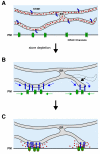Some assembly required: constructing the elementary units of store-operated Ca2+ entry
- PMID: 17499354
- PMCID: PMC2323433
- DOI: 10.1016/j.ceca.2007.03.003
Some assembly required: constructing the elementary units of store-operated Ca2+ entry
Abstract
The means by which Ca(2+) store depletion evokes the opening of store-operated Ca(2+) channels (SOCs) in the plasma membrane of excitable and non-excitable cells has been a longstanding mystery. Indirect evidence has supported local interactions between the ER and SOCs as well as long-range interactions mediated through a diffusible activator. The recent molecular identification of the ER Ca(2+) sensor (STIM1) and a subunit of the CRAC channel (Orai1), a prototypic SOC, has now made it possible to visualize directly the sequence of events that links store depletion to CRAC channel opening. Following store depletion, STIM1 moves from locations throughout the ER to accumulate in ER subregions positioned within 10-25nm of the plasma membrane. Simultaneously, Orai1 gathers at discrete sites in the plasma membrane directly opposite STIM1, resulting in local CRAC channel activation. These new studies define the elementary units of store-operated Ca(2+) entry, and reveal an unprecedented mechanism for channel activation in which the stimulus brings a channel and its activator/sensor together for interaction across apposed membrane compartments. We discuss the implications of this choreographic mechanism with regard to Ca(2+) dynamics, specificity of Ca(2+) signaling, and the existence of a specialized ER subset dedicated to the control of the CRAC channel.
Figures



Similar articles
-
The elementary unit of store-operated Ca2+ entry: local activation of CRAC channels by STIM1 at ER-plasma membrane junctions.J Cell Biol. 2006 Sep 11;174(6):815-25. doi: 10.1083/jcb.200604015. J Cell Biol. 2006. PMID: 16966423 Free PMC article.
-
Oligomerization of STIM1 couples ER calcium depletion to CRAC channel activation.Nature. 2008 Jul 24;454(7203):538-42. doi: 10.1038/nature07065. Epub 2008 Jul 2. Nature. 2008. PMID: 18596693 Free PMC article.
-
STIM1-Orai1 interactions and Orai1 conformational changes revealed by live-cell FRET microscopy.J Physiol. 2008 Nov 15;586(22):5383-401. doi: 10.1113/jphysiol.2008.162503. Epub 2008 Oct 2. J Physiol. 2008. PMID: 18832420 Free PMC article.
-
Regulation of CRAC channels by protein interactions and post-translational modification.Channels (Austin). 2013 Sep-Oct;7(5):354-63. doi: 10.4161/chan.23801. Epub 2013 Mar 1. Channels (Austin). 2013. PMID: 23454861 Free PMC article. Review.
-
The STIM/Orai coupling machinery.Channels (Austin). 2008 Jul-Aug;2(4):261-8. doi: 10.4161/chan.2.4.6705. Epub 2008 Jul 21. Channels (Austin). 2008. PMID: 18769136 Review.
Cited by
-
Bombyx mori homologs of STIM1 and Orai1 are essential components of the signal transduction cascade that regulates sex pheromone production.J Biol Chem. 2009 Nov 6;284(45):31200-13. doi: 10.1074/jbc.M109.044198. Epub 2009 Sep 9. J Biol Chem. 2009. PMID: 19740753 Free PMC article.
-
Agonist-activated Ca2+ influx occurs at stable plasma membrane and endoplasmic reticulum junctions.J Cell Sci. 2010 Dec 1;123(Pt 23):4170-81. doi: 10.1242/jcs.068387. Epub 2010 Nov 9. J Cell Sci. 2010. PMID: 21062895 Free PMC article.
-
STIM1 is a MT-plus-end-tracking protein involved in remodeling of the ER.Curr Biol. 2008 Feb 12;18(3):177-82. doi: 10.1016/j.cub.2007.12.050. Epub 2008 Jan 31. Curr Biol. 2008. PMID: 18249114 Free PMC article.
-
STIM and Orai proteins: players in sexual differences in hypertension-associated vascular dysfunction?Clin Sci (Lond). 2009 Dec 15;118(6):391-6. doi: 10.1042/CS20090449. Clin Sci (Lond). 2009. PMID: 20001956 Free PMC article. Review.
-
Activation and regulation of store-operated calcium entry.J Cell Mol Med. 2010 Oct;14(10):2337-49. doi: 10.1111/j.1582-4934.2010.01168.x. J Cell Mol Med. 2010. PMID: 20807283 Free PMC article. Review.
References
-
- Parekh AB, Putney JW., Jr. Store-operated calcium channels. Physiol. Rev. 2005;85:757–810. - PubMed
-
- Lewis RS. Calcium signaling mechanisms in T lymphocytes. Annu. Rev. Immunol. 2001;19:497–521. - PubMed
-
- Putney JW., Jr. A model for receptor-regulated calcium entry. Cell Calcium. 1986;7:1–12. - PubMed
-
- Putney JW, Jr., Bird GS. The inositol phosphate-calcium signaling system in nonexcitable cells. Endocr. Rev. 1993;14:610–631. - PubMed
-
- Penner R, Matthews G, Neher E. Regulation of calcium influx by second messengers in rat mast cells. Nature. 1988;334:499–504. - PubMed
Publication types
MeSH terms
Substances
Grants and funding
LinkOut - more resources
Full Text Sources
Miscellaneous

